Downloads
Introduction1
Thank you for the opportunity to speak to you.
My focus today is the re-emergence of China and India into the global economy. This is the global economic development likely to have the biggest impact on the industrial structure of the Australian economy over the next decade or more. Together accounting for slightly more than one-third of the people on the planet, China and India are growing rapidly and are likely to continue to do so, which will continue to raise demand for mineral and energy commodities of which Australia has abundant supply.
The implications for Australia will depend on how rapidly the global supply of commodities rises to meet rising global demand, and on whether any economic or political events conspire to interrupt (or derail?) the rapid economic growth that China and India have enjoyed for the past couple of decades. But as I will discuss later in my talk, the re-emergence of China and India into the global economy has broader implications for Australia than simply heightened demand for our mineral and energy commodities.
Re-Emergence of China and India
The most striking manifestation of China's and India's rapid growth on the Australian economy is the behaviour of the terms of trade over the past several years. Australia is currently experiencing the largest sustained boost to the terms of trade in our history (at least it is if forecasts for the terms of trade over the next couple of years are roughly correct). As far as the data allow us to make such comparisons, the current five-year centred moving average of the terms of trade is much higher than it has been at any time in the past 140 years (Chart 1).
Terms of trade (Index 1900-01 to 1999-00 = 100)
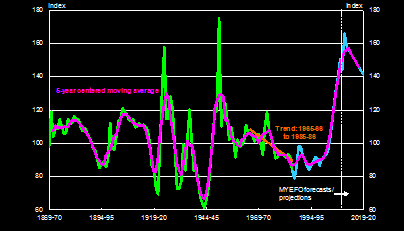
Source: ABS Catalogue Number 5206.0, RBA and Treasury.
This high level of the terms of trade is having a profound impact on the Australian real exchange rate, which is at its highest level, and currently about 35 per cent above its average over the 27 years since the Australian dollar was floated in December 1983 (Chart 2). This in turn is having a profound impact on the structure of the traded sector of the Australian economy. In particular, those parts of the traded sector not linked in some way to the boom in the production of mining and energy commodities are facing severe and sustained competitive pressure from foreign competitors.
Australian real exchange rate (Post-float average = 100)
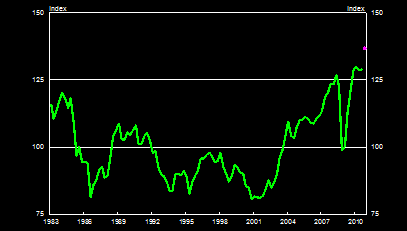
Source: Reserve Bank of Australia and Treasury.
An issue of central interest is the length of time over which the level of the terms of trade, and hence the real exchange rate, are likely to remain well above their pre-boom average levels.
On this point, it is worth noting that the high terms of trade are being driven predominantly by rapid economic growth in Asia, and particularly in the Asian giants, China and India. Even though China and India have been growing rapidly for the past few decades, they remain at the early stages of their economic development. Their standards of living relative to that of the developed world (as proxied by the ratio of their GDP per capita at PPP exchange rates to that of the 15 OECD countries with the highest standards of living) are currently lower than was Japan's standard of living in the early 1950s relative to that of the developed world at that time (Chart 3)
GDP per capita (Per cent of OECD-15 average)
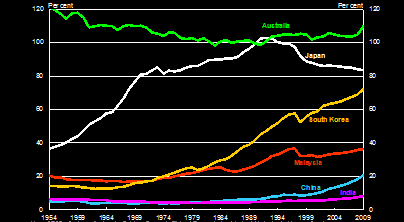
Note: OECD-15 = Australia, Austria, Belgium, Denmark, Finland, France, Iceland, Ireland, Netherlands, Norway, Sweden, Switzerland, UK, US and Canada.
Source: The Conference Board Total Economy Database and Treasury.
From this level of development relative to the developed world, Japan – followed by a string of other East Asian economies – experienced strong catch-up growth for a few decades as their standards of living climbed closer to that of the developed world. Based on this experience, China and India have the potential for strong catch-up growth for at least a few more decades. Of course, nothing is for sure, and a range of accidents could intervene to render this prediction wide of the mark.
In the case of China, export-led growth has been supported for some time by a number of implicit subsidies to exporting firms, in the form of low regulated interest rates, a low wage share, and a low exchange rate. The resulting disequilibria in the Chinese economy are now being felt in the form of significant consumer and asset price inflation. China faces the short to medium-term challenge of unwinding these disequilibria without suffering a significant interruption to its economic growth.
Thus, while there are sound reasons to expect strong average rates of catch-up growth in China (and India) over the next few decades, this growth may be punctuated at times by significant volatility.
Along with rapid economic development comes rising urban population shares and, at least at these early stages of economic development, rising per capita consumption of a range of mineral and energy commodities (Charts 4 and 5).
Urban population shares
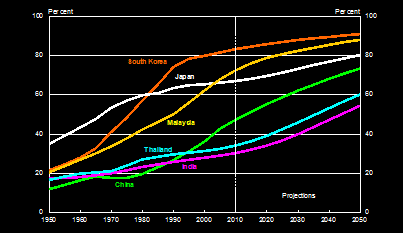
Source: United Nations population database.
Consumption per capita
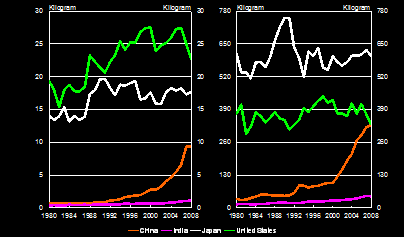
Source: ABARE, Steel Statistics Yearbooks and Treasury.
It therefore seems most likely that there will be strong growth in demand for the mineral and energy commodities that Australia produces for some time to come (although, undoubtedly, there also will be bouts of volatility in this demand). This strong demand is currently particularly pronounced for iron ore and coal although, as global efforts intensify to reduce greenhouse gas emissions, demand for lower emission-intensive energy sources, like natural gas and uranium (of which Australia also has abundant supplies), may grow at the expense of coal.
By itself, strong growth in demand does not guarantee that commodity prices (and therefore Australia's terms of trade) will remain high. The extremely high rates of profitability associated with the production of these commodities are bringing forth very significant global supply responses.
How will this interplay between global demand and supply play out? One possibility, which presumes no serious prolonged adverse developments that derail the catch-up process in China and India, is that average prices for commodities remain relatively high – well above the average cost of production – for an extended period to maintain strong financial incentives for continued rapid exploration and development of new mining capacity (Garnaut, 2006).
An alternative possibility is that, in the rush to exploit the current extremely high rates of profitability, so much global supply is brought on stream that commodity prices fall substantially over the next several years – back closer to the marginal cost of production, or eve
n below it for some time.
While these are both possibilities, it seems most likely that the terms of trade will be significantly higher on average over the next couple of decades than they were in the couple of decades preceding the current mining boom.
High resource prices, combined with a high Australian real exchange rate, are currently driving factors of production – both labour and capital – out of non-resource parts of the traded sector (including many, but not all, parts of manufacturing) and into mining and construction (Chart 6).2
Australian employment and investment
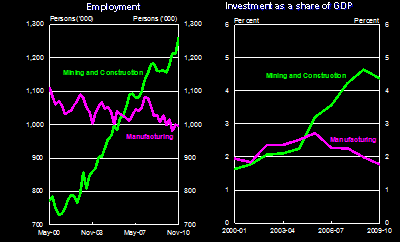
Source: ABS Catalogue Numbers 5206.0, 6204.0, 6291.0.55.003 and Treasury.
The strongly rising share of employment in the mining and construction sectors is a relatively recent phenomenon, dating from the beginning of the mining boom, around 2003-04. But the associated decline in the share of employment in manufacturing is not a recent phenomenon. It is instead the continuation of a trend that has been evident for a few decades (Chart 7).
Three speed economy – employment share by industry
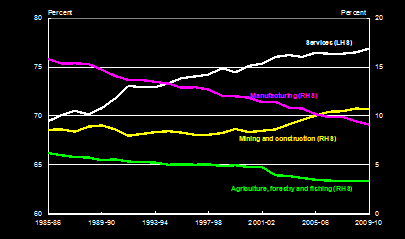
Source: ABS Catalogue Number 6291.0.55.003 and Treasury.
Another development highlighted by Chart 7 has been less remarked upon. Over the past couple of decades, services sectors have accounted for a rising share of employment, and this trend has been affected hardly at all by the mining boom. Taken together, the services sectors now account for over three-quarters of the employment in the economy.
It is also important to keep in perspective the relative sizes of the sectors of the economy. Although there has been strong employment growth in mining and construction, service sectors (particularly health care and social assistance; professional, scientific and technical services; and education and training) have together accounted for far more of the economy's employment growth since the beginning of the mining boom than have mining and construction (Chart 8).
Employment change by industry (2003-04 to 2009-10)
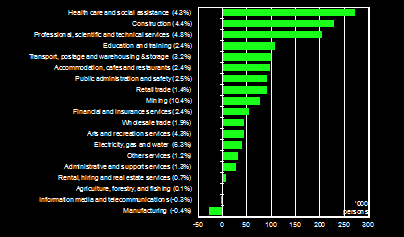
Note: Average annual growth in parentheses.
Source: ABS Catalogue Number 6291.0.55.003
Even if the terms of trade remain high (which, in turn, may lead to continued strong employment growth in the mining and construction sectors – though this is clearly not assured), it seems most likely that growth in the number of people employed in the service sectors will continue to outstrip growth in the number employed in mining and construction.
A related development, and one that is also likely to be relevant over the next decade or more, is increased direct competition in the non-resource parts of the Australian traded sector from China and India, with flow-on effects to employment in those sectors of the Australian economy. The most obvious parts of the Australian traded sector likely to be subject to this increased direct competition are manufacturing – especially as Chinese and Indian production moves to increasingly sophisticated manufacturing goods (for example, automobiles) as their real wages rise, but also parts of the service sectors that may become increasingly tradeable, as a consequence of further development of the internet. The high level of the Australian dollar acts to accelerate these trends.
Dutch Disease?
Let me conclude my remarks with an important question about the Australian resources boom: should it be considered an example of 'Dutch disease'? The term 'Dutch disease' was coined in a 1977 article in The Economist magazine in reference to the Dutch experience following the discovery of a large natural gas field. At the time, the resultant real appreciation of the Dutch currency, combined with enhanced competition for labour and capital, saw a decline in the Dutch manufacturing sector and a rise in Dutch unemployment.3 It was argued by some that, once the natural gas field had been exhausted, the Dutch real exchange rate would return to pre-boom levels but that, when that occurred, the Dutch manufacturing sector would not be in a position to recover to pre-boom levels of activity, because the exit of some significant firms from the sector, and the loss of sector-specific skills, would prove irreversible.
Put in other words, the idea was that a short-lived development – the discovery and exploitation of a natural gas field – might do longer-term, and possibly irreversible, harm to the pre-boom domestic industrial structure that was consistent with Holland's longer-term comparative advantage out into the future.
Without passing judgement on the relevance of this line of argument to Holland's circumstances in the 1970s, it is worth considering its relevance to Australia's current circumstances. As I have said above, those parts of the Australian traded sector not linked in some way to the resources boom are currently facing severe and sustained competitive pressure from foreign competitors because of the appreciation of the real exchange rate.
But, as I have stressed, the predominant reason why we are seeing this structural change in the Australian traded sector is because of the re-emergence of the Asian giants, China and India, into the global economy. Asia has for some decades been the region of the world enjoying the fastest rates of economic growth and, in the view of most commentators, this is likely to continue for some decades to come. As well as generating huge and growing demand for energy and mineral commodities, this rapid economic growth is also delivering millions of people into burgeoning middle classes, in China, India and elsewhere in Asia.
Given our geographic location, as well our resource endowments, Australia is in a position to benefit enormously from these developments. We are currently benefitting from a huge increase in demand for our mineral and energy resources. For how long this will last remains a matter of conjecture. But in the longer term, the increasing numbers of people in the Asian middle classes, with disposable incomes to match, will generate rising demand for a range of Australian goods and services – whether they be a range of foodstuffs, Australian tourist destinations, or educational, financial and other professional services in which Australia has a proven track record.
It is not possible to predict with any accuracy which of these Australian economic sectors will benefit most from the re-emergence of China and India into the global economy. That is an argument for maintaining, and enhancing where possible, the flexibility of the Australian economy.
And, regardless of which Australian economic sectors will ultimately benefit most from the re-emergence of China and India, this global changing of the guard seems more like a generational change in Australia's comparative advantage than it does an example of Dutch disease, in which we might wish to return Australia to its pre-boom industrial structure once a short-lived disturbance has passed.
* Please see the PowerPoint slides for the Charts referred to in this paper.
References
Garnaut, Ross 2006, 'The China Resources Boom', paper presented to the Austral
ian Agriculture and Resource Economics Conference, Sydney.
Gregory, R. G. 1976, 'Some Implications of the Growth of the Mineral Sector', The Australian Journal of Agricultural Economics, Vol. 20, No. 2, pp.71–91.
The Economist, 26 November 1977, 'The Dutch disease', p. 82-83.
1 I am grateful to Roger Brake, Adam McKissack and Steve Morling for helpful comments.
2 Much of the rise in construction activity and employment is associated with the mining sector, but some is associated with higher infrastructure spending by State and Federal Governments.
3 In Australia, Dutch disease is an example of the 'Gregory effect' after a seminal 1976 article by Professor Bob Gregory.